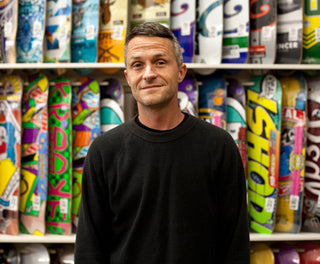I’ve known my friend Jerry Harris for about as long as I’ve been in this industry. We met back in 2006 when I was still living in the East Bay and he was opening his second retail store, Bows & Arrows. Although our meeting wasn’t official until then, I grew up down the street from his first shop, 510 Skateboarding, and remember walking past it every time I’d head down Telegraph Ave. Always down to have a chat about the state of this industry, Jerry is one of those people whose opinion I respect a ton and someone who captures my attention every time he tells a story about the history of skateboarding and streetwear. As the premier destination for skate within the East Bay, he holds a very important stake in the legend of Bay Area skateboarding.
On my recent trip to San Francisco, I made my way across the Bay Bridge to catch up with my old pal and get the scoop on how his dream of opening a skate shop became a reality, but most importantly, how he’s managed to weather the retail storm time and time again, and still emerge triumphant. Rather than ruin the moment with a ton of questions, I sat back and listened to Jerry’s tell his tale, available below for your reading pleasure.
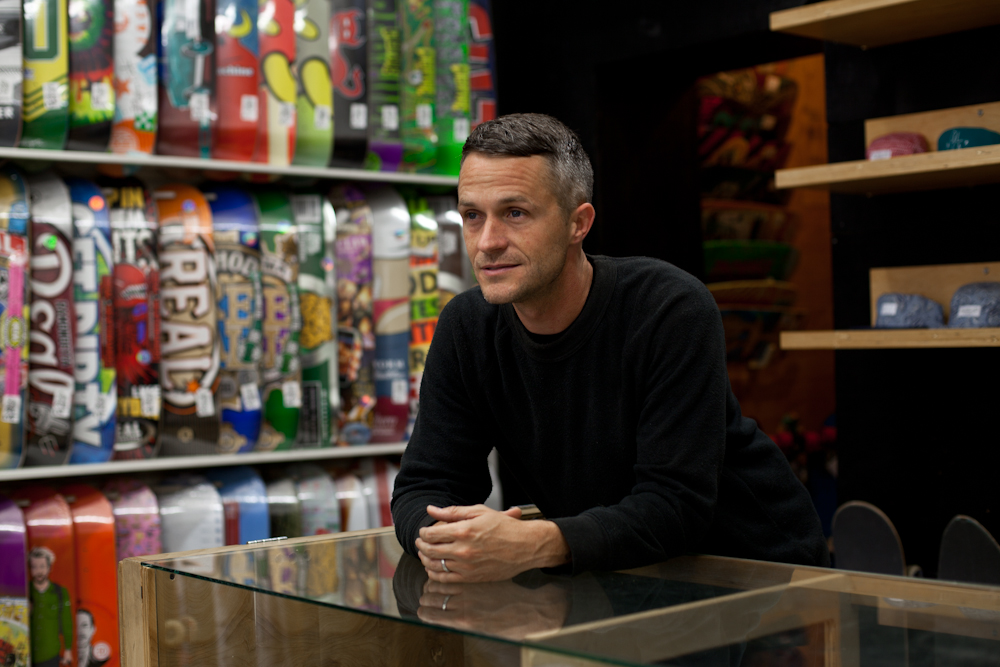
A rare portrait of 510 Skateboarding founder Jerry Harris pretending I’m not shooting him
MOVING TO SAN FRANCISCO
When I moved to San Francisco, it was a skateboard mecca. It was this big fucking deal to be a skateboarder in San Francisco. Not to the mainstream, but to skateboarders, SF was kind of the hub of what was going on. Everything that I thought was cool in skateboarding. FTC was, and still is, great, but it was the coolest place. You’d go into FTC and they’d have Jordans on the wall and adidas shell toes, because that’s what people were skateboarding in. It was just this totally progressive skateboard scene and FTC really nailed it. They were so representative of what was going on in that city and what was going on at the time.
Once I started coming over to the East Bay to meet Dandy, my wife, then girlfriend, I was kind of surprised at how lacking the scene was over here. There was just no epicenter, no meeting place. It was just really spread out… That’s why when we opened, we just really wanted to be that for the East Bay—for Berkeley and Oakland. It wasn’t like, “Oh, we’re going to be some big clothing brand someday.” Or anything even along those lines. It was like, “We’re going to be a hub for skateboarders in this area that we really like.” I think through that the skateboarding scene in the East Bay has evolved a lot.
[Berkeley] has always been a lot different from San Francisco, but kind of linked at the hip at the same time. It definitely has its own distinct feel. I don’t think it’s changed, I don’t think the skateboarding scene has changed over here a lot, but I think it’s grown just like it has anywhere else. It’s still grimy, it’s still dudes in warehouses and all they give a shit about is skateboarding and building cool places to skateboard. It’s so different from what you see a lot in Southern California where you have the contest circuit. The contest kids and the skate park moms and all that stuff. It’s definitely kept a pretty strong indie feel. The skateboard industry has grown up and gotten all huge around us, but the scene around here has stayed pretty grimy [laughs], pretty authentic.
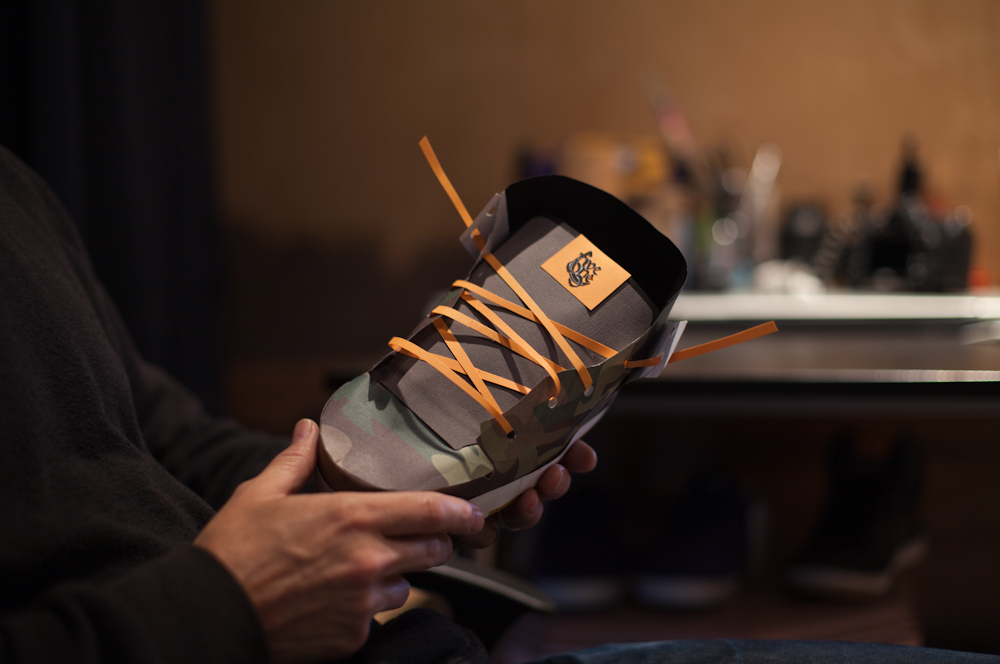
A fan-made paper version of the shop’s recent Dunk collaboration with Nike SB
510 SKATEBOARDING FINDS A HOME ACROSS THE BAY
We opened in ’98—skateboarding was in this dumps of the ‘90s where your average person didn’t give a shit about it. So we opened in a market that was totally small, it was essentially easy to get accounts, it wasn’t saturated. And right after we opened, for two years, it just started moving up again. There were all kinds of stuff going on that put skateboarding in the public spotlight. You had the Tony Hawk video game, X-games, and all these things that brought skateboarding into the mainstream.
I think the main reason that happened so out of the gate is because we were in such a prominent location; there was just a lot of people around. Any business class will tell you: location, location, location. I don’t know if the same rules apply now. I think social media is kind of giving people the ability to be off the beaten path and still have a presence. Whereas when we were opening up the store if we were off the beaten path – minus the social media – you didn’t exist.
At the time this location (Telegraph Ave.) was really important and one thing that worked for us that we hadn’t really anticipated or predicted was our timing. That’s another thing I’ve learned a lot about business is that timing is really, really important. You can’t plan for what’s going to happen because at the end of the day nobody really knows. We were just super well-positioned in a really busy area and were the only skateboard shop around. Plus, we had these really cool, hard-to-get skateboard accounts all of a sudden. Ever since then we’ve always appreciated that; that a lot of it was our timing, it wasn’t even stuff we planned for. We were just totally fortunate. But I think we’ve also worked hard and are happy with our business. We like having one skateboard shop that’s intended to service and represent what we consider one of the raddest skateboard scenes there is.
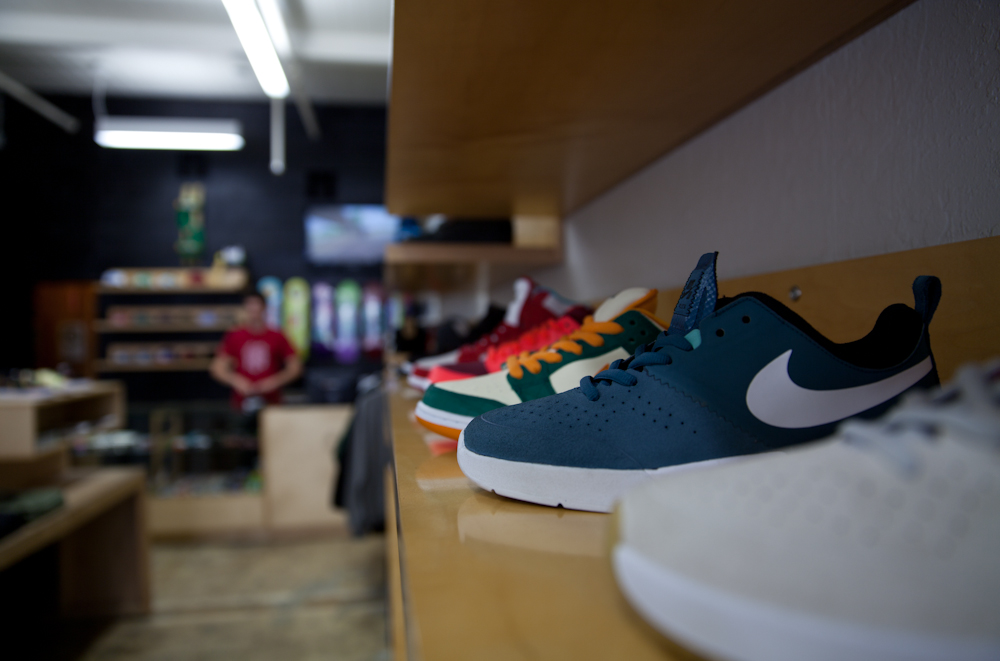
Shelves stocked with the latest from Nike SB
TAMING THE CORPORATE GIANT AND THE INTRODUCTION OF NIKE SB
I have a lot of memories and theories as to why Nike SB worked.
So Nike tried to get into the skateboard scene a few times, but their timing was really bad and their approach wasn’t as solid either. Their timing for SB, as well as their approach – the chemistry of when SB started – was just perfect. And I think some of it was really well-planned and I think some of it was luck. It wasn’t luck but it was because they were going to keep going after it until it worked. So it was persistence, it was going to work eventually. It was just that it hadn’t worked yet, so they weren’t just going to roll over, obviously.
At the time, there was this local [sporting goods] chain called Copeland’s, which opened stores within a couple miles of us, like, on every side. And they had huge skateboard sections in their stores. A lot of it was off-price – by anybody who understands retail and demand and the area, they had way too much inventory to sell to the amount of kids that were buying skateboard stuff around here. Especially considering they had all these stores within a few miles of each other. But they were the exciting new retailer or opportunity for a lot of these small skateboard brands that were chasing growth. They were over-excited – I think the industry as a whole was over-excited – and they saw opportunities like this new, big chain expanding into skateboarding as ways to sell. A lot of these bigger chains can be really persuasive as far taking reps out on a vacation weekend and flying them in their helicopter. I heard stories of guys from Oakland, reps, going on helicopter rides with the guys and all this shit.
So all of a sudden I’m the little skateboard shop guy here in town and I have these sporting goods chains all around me. Every single cool skateboard company that we supported was fully represented on their walls. Every skate shoe brand we had carried… We’d been the only place in town, it was this total specialty market that was growing, we were doing well with it. And all of a sudden this sporting good chain that’s surrounding us has everything we have and more and half the time it’s on sale. Being local and being a skateboarder from the area and working in the retail side of it and just being into the business side of things, it always seemed off to me how much inventory they had, and how off-priced so much of it was most of the time. I didn’t think it was sustainable. I didn’t think they were selling enough or were actually making growth to actually be making money so I didn’t think it was working. I didn’t know what was going on behind the scenes but I knew that it didn’t make sense.
But for a couple years, we were dying. We were just getting killed. Our numbers had tapered off substantially and we were bare bones as far as staff goes. I was working crazy hours. It was never close to the point where we were going to close, but it looked like if things continued on the path they were on then we weren’t going to be around in a few years. I kind of lost my trust and affinity for a lot of these smaller skate brands. I felt sort of betrayed. In business, we all understand that it’s business, everybody’s doing what they have to do, what they want to do, what they feel like they need to do to survive. But you do have personal relationships and there’s trust there – and just growing up liking a lot of these brands – so all of a sudden feeling that feeling of being tossed out for this shitty sporting goods chain sucked. It wasn’t even like it was for some cool better skateboard shop that deserved to take our place. It was this place that totally devalued their product. Marked it down constantly, sold it for below what wholesale was half the time – just devalued the product. In my opinion wasn’t doing the industry any favors, besides maybe making everybody some short-term extra cash.
So Nike comes along all of a sudden, while all this is going on and they say, “Hey, we really like your cool little skateboard shop, this is a cool skateboarding scene and we know you guys are heavily involved in it. We’d like you to carry our line of skateboard shoes.” And having lost my affinity, like I said, for a lot of these independent skateboard brands – or lost my trust in them – I was kind of open to trying something else—I needed to at the time. And then I saw the product and I really liked it, I just thought it was cool. Like I said before, when I went into FTC in the ‘90s and I saw they were carrying Jordans or whatever, I was like, “Oh, even though it’s not made for skateboarders, maybe, it looks like stuff that people that really skateboard and know what’s up with skateboarding might be interested in wearing.” And as weird as this kind of sounds now, it was something different.
The Dunk was the first shoe that they were bringing in and it was just way different than what skateboard companies were making at the time and I was getting my ass kicked in that market anyways. So it was like, “Okay, here’s a product that I like, I like the team,” – okay, so there’s several factors – so Nike could have went the big money route, they could have got Tony Hawk and all these X-Games heavy hitters, but, instead they went after all these skateboarder-skateboarders. Like, the guys you only knew of or appreciated if you were a skateboarder yourself. Guys that were great skateboarders, had good skateboarding careers, but weren’t big names outside of it.
It was weird, it was all the heritage and legacy of Nike and the iconic ‘80s silhouette of The Dunk, except it had this indie feel. It had this small brand feel. So SB felt like this cool new thing but at the same time it had the heritage thing that comes with Nike. I go for it, and we’re kind of late on the first season of SB’s and they were over sold on a lot of stuff, so they’d send us some patchy side runs of that first season’s releases and we sold them pretty good. And then the first full pre-book season we got was the Orange Flash, the Loden, and the Shark. So those three shoes came in and we got big size runs of all of them. I just really liked them. I was out of town at the time so I called the guys at the shop the day after to tell them to set a pair aside for me in my size of one of the colors, and they were gone. I was like, “Could you put aside –“ and they said they’re gone. And I was like, “What? We sold out in my size already?” And they were like, “No, the shoes are gone. All of them. It’s been crazy in here.” And all of a sudden, not only did I have this new line of product that I personally thought looked cool, I thought the whole approach was really cool and special for the time. When everybody was chasing growth, here was a big company looking for a niche market appeal. It just really spoke to me.
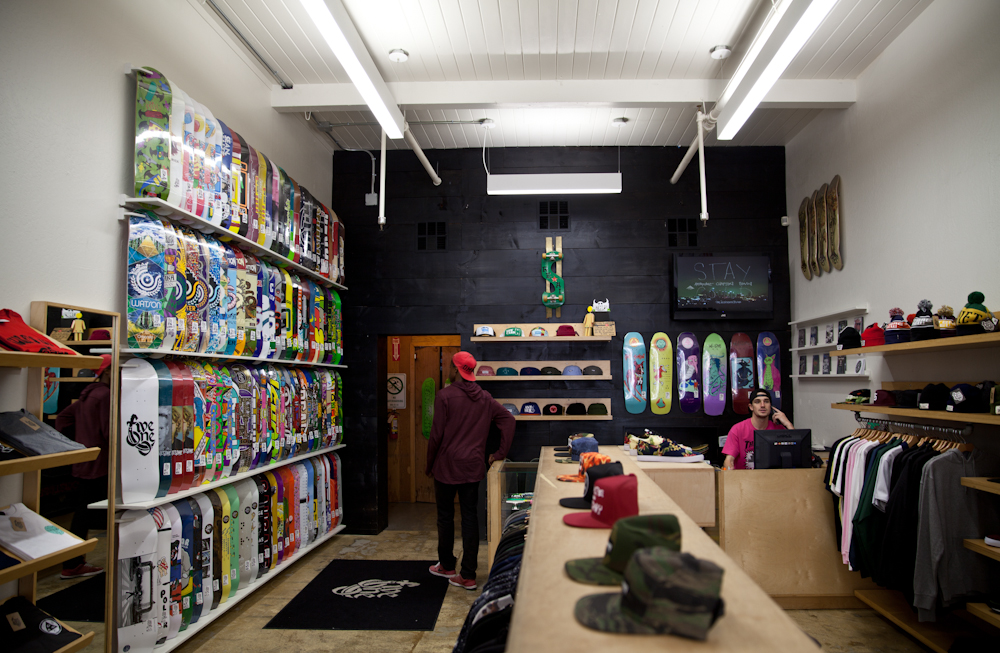
A look inside 510 Skateboarding on Telegraph Ave.
SURVIVAL OF THE FITTEST
[Nike SB] went totally backwards, they did the opposite of what all these other guys were doing – because they could. As a retail store, you always need something that’s really working. You can work around it and you can build other things with that but you need something that’s pulling people. Just that momentum, that energy is so important.
That first release we got – like I said – pre-internet pre-social media kind of prominence, I just really hadn’t anticipated the demand. And I think since we hadn’t really had that before, like, the phones weren’t ringing off the hook . To me it was really out of the blue. I didn’t know about message boards or people chatting about Nike. It just wasn’t even a thing to me. But we got those in and they sold and I had this whole new level of confidence in my business again. It was just like, “Okay, well, it’s on.” This is going to ensure our survival.
A few years later, Copeland’s files bankruptcy and almost takes a bunch of those guys with them – because they owed them so much money – and in hindsight, I had kind of been right all along. I didn’t know how it was going to survive, or how it was making money, or how it was doing what it was doing and it’s because it wasn’t; it wasn’t making money. It was an illusion of someday growth and just whatever over too much credit or financing and whatever else. [After] Copeland’s went bust, our business really picked up again. Once we had three sporting good stores completely surrounding us go away, and we’d had all this new momentum behind Nike SB working and being the only store in the area that had that, then it was back on.
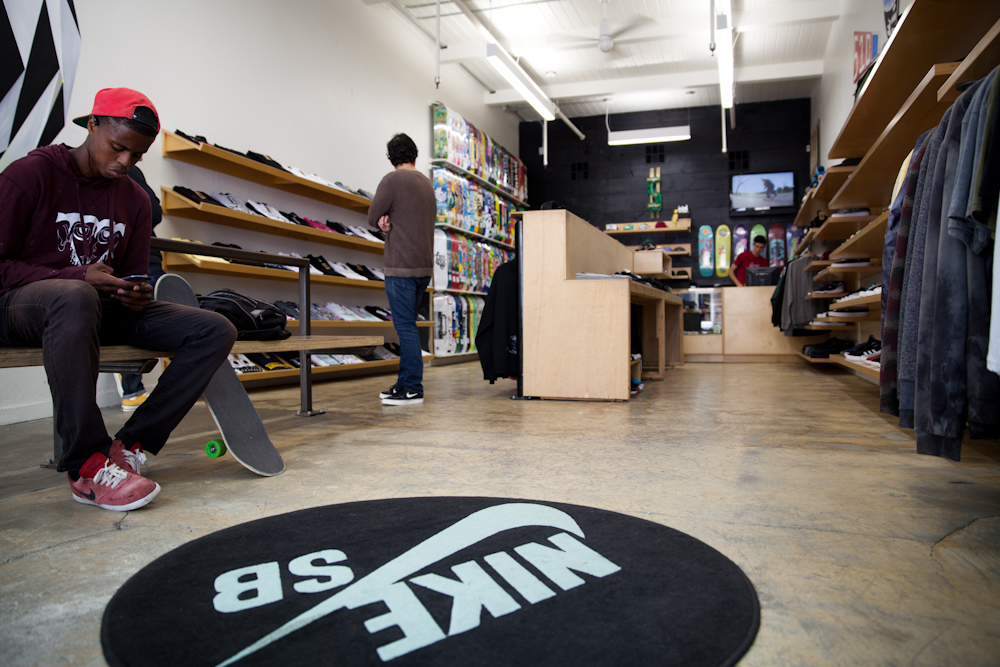
STAYING RELEVANT IN AN ONLINE LANDSCAPE
In my opinion, one of the things that has kept us here and kept us relevant is just our priorities and our goals. Like I said, it’s not really to be some big mega brand, we’re not trying to compete with big box stores or whatever. As things continue to evolve, as internet shopping gets more convenient and more prominent or as more competitors move into the area I don’t know if we’ll be able to survive with the same formula. Maybe we’ll have to change. I think we have evolved though over the years. Just focusing on our core business and our store and our priorities has kept us relevant. Our focus has never been growth. Which I think is what most businesses focuses are. I don’t mean we’re not trying to grow, it’s just not at the top of our priorities.
I think one thing that can distinguish us from, say, a big-box store or a big brand who wants to do more direct consumer rather than middle man through us, by finding cool new shit. That’s one area where I can be fast, I can move super fast. If there’s a new brand and I see them on wherever I see them – whether it’s social media or if I see some cool shit that I think is exciting then I can just bring it in. But that’s kind of an over-simplification. I think over time I’ve gotten a pretty good eye for what people are going to get excited about, depending on what’s going on in the market.
I think right now we’re seeing another wave in the skateboard industry in particular I think everything is really oversaturated. Everything is over-produced and over-distributed. It’s not bad—it’s just the same. It’s not exciting, I don’t think it brings anybody into a store. I think people will come in and buy it because it’s familiar and they like it. But it just lacks energy.
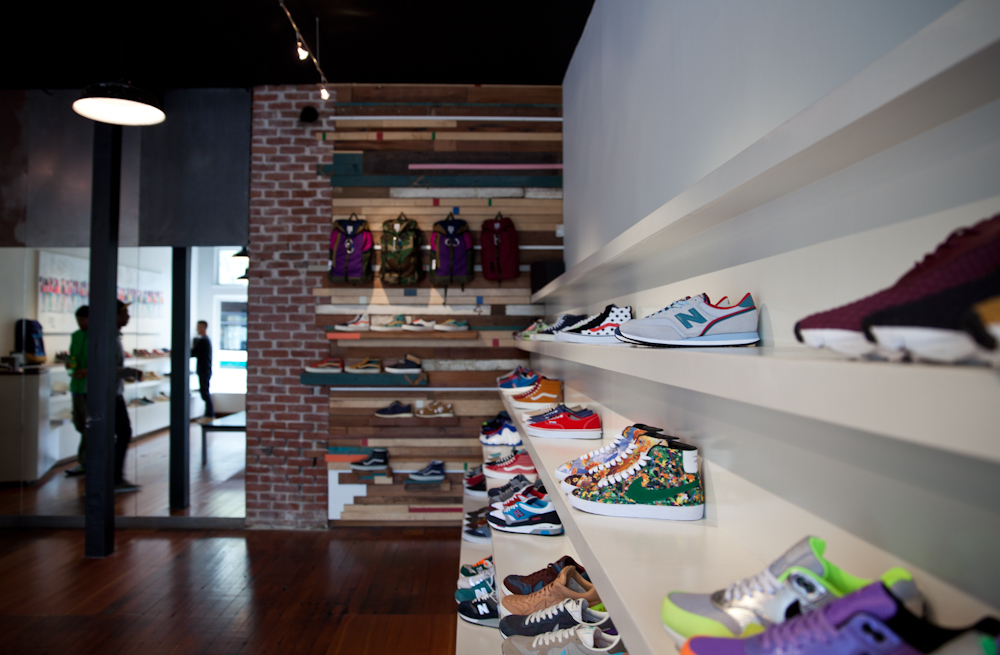
AUTHENTICITY MATTERS
What’s happened in the footwear side of skateboarding is that all these legacy brands have become really dominant, obviously. So those have kind of taken over the footwear wall. I don’t think they have it as locked in as they think they do, I think they’re kind of overconfident in that category. A lot of big brands think they can sell wherever and do whatever they want and they’re just gonna own it. Im seeing something a little different personally, on the ground – I think a lot of skateboarders want something different, but it needs to be from a brand that they respect.
One area I can provide that in and is low risk to me is with hard goods and with clothing. I can find new shit – there’s a whole mini movement in the skateboard industry right now of smaller hard goods brands that are trying to appeal to stores like ours and people that shop at stores like ours. And I’m totally supporting those brands, if those brands are going to sell for me I’m going to work hard to get those brands to work for us. If those brands grow and decide to distribute more broadly, I’ll find the next new shit. And if they decide to do what we do and just stay small and stay indie and focus on your core consumer in your business then we’ll probably have a pretty long-term relationship with them.
But finding new stuff, I think, is key. This is going off the subject a little bit – but in Bows and Arrows, it’s really hard to find new shit right now. People want Nike’s, they want Jordans, and now they want adidas, but is that really new?
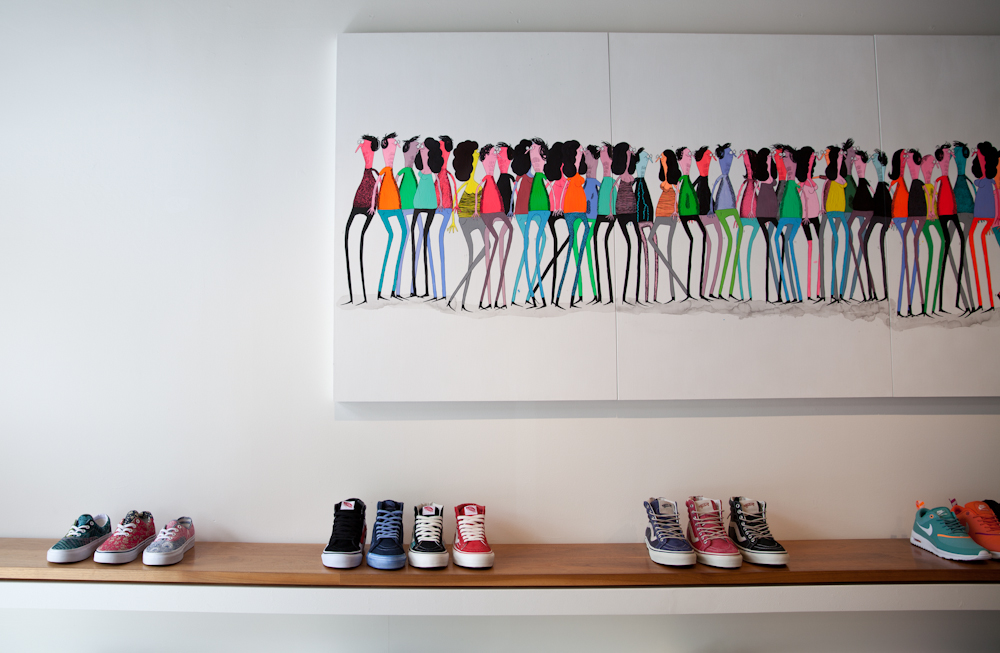
THE OPENING OF BOWS AND ARROWS
As I started working with Nike and got more exposure in that world and started seeing all these sneaker dudes coming in, this whole new thing opened up to me that was just out there, that had never really been in my view before, which was a specialty sneaker market. So I started getting more interested, myself, in the product and there were times when I considered carrying some things at 510, but I felt like that would really take away from my core perspective which was, “We are a skateboard specialty store.” That doesn’t mean I don’t think there’s a lot of cool shit outside of skateboarding or skateboarding specialty – there’s a lot of bullshit within it – but the way I vibe 510 is if I think it will appeal to skateboarders that I consider a legit skateboard crowd, then I’ll carry it. Hopefully it sells beyond that even. But if I feel like it’s not legit within that world I really just don’t go there. I think we just try to be – I fuck up of course – but I try to be honest in there. I want kids who walk in there to leave feel like if they leave there, they’re going to look like a legit skateboard kid [laughs]. Whether or not they are I don’t know, I can’t say that but that’s what we want to provide.
Bows and Arrows, it just made sense. I had accounts with Vans and I really like Vans Vault which was kind of a new thing – at the time it was brand new actually. I liked a lot of the stuff going on outside of Nike SB, all of a sudden they were starting to do more specialty releases, it was becoming a thing. I’ve always liked adidas, adidas is a super cool brand, crazy, awesome story behind that one. I wanted to sell that shit. A.) A lot of it didn’t make sense in 510 and B.) I didn’t have room for it anyways; so we decided to open that store. It was a couple years – it was a little bit before we really, really committed to opening that store. We opened that store, I think, at the height of the previous sneaker boom, ’06 I would say was the height of the sneaker boom. HUF and Undefeated and a lot of those guys were really impactful during that era because they were new and super exciting. Now we have newer guys that are more impactful than, say, – well, obviously HUF’s not in that world anymore – but, like, Undefeated; you have, like, Concepts. And I don’t think it’s necessarily because Undefeated has done anything wrong, they’ve just been around longer so it doesn’t have the same new and exciting feel – it doesn’t have the same energy behind it, whatever the reason is, I don’t know.
Those guys are focused on a lot more too now. Like Undefeated, obviously, have their own brand and HUF’s not even doing it anymore. But my point is, during that era, there was already established, badass, heavy hitter dudes in that world. So we saw that going on and respected what those guys were doing and wanted to find something like that again; something like that for this area. But that store took me longer to figure it out. Because I was newer to that world and now we’ve had Bows and Arrows for almost ten years. Now I feel like I’m a veteran in that industry too. But it took us way longer to get established in there and even now that industry is so different than the skate industry; there’s no loyalty. You have loyalty in the skateboard industry on some level. For the business world I think skateboarding has a lot of loyalty—that industry. For the sneaker world, it’s just more competitive, more cutthroat. I think just because it’s bigger, there’s more players, more money, and it’s just the name of the game. I didn’t even know anybody else from that world for years even after owning Bows and Arrows.
Really just in the last few years have I started to meet other sneaker storeowners. And mostly the guys that I have met or who I have talked to at all or who I like at all are the kind of guys that have similar backgrounds, a lot come from the skateboard world; a lot of the same experiences. Skateboarding shop is a trend – there’s an element of trend there but there’s also an element of community. Where in the sneaker world it’s all trend. I think there’s some level of community but it’s solely based on consumers. Where skateboarding, I think, is a little deeper than collecting or consuming. It’s just a different sort of community.
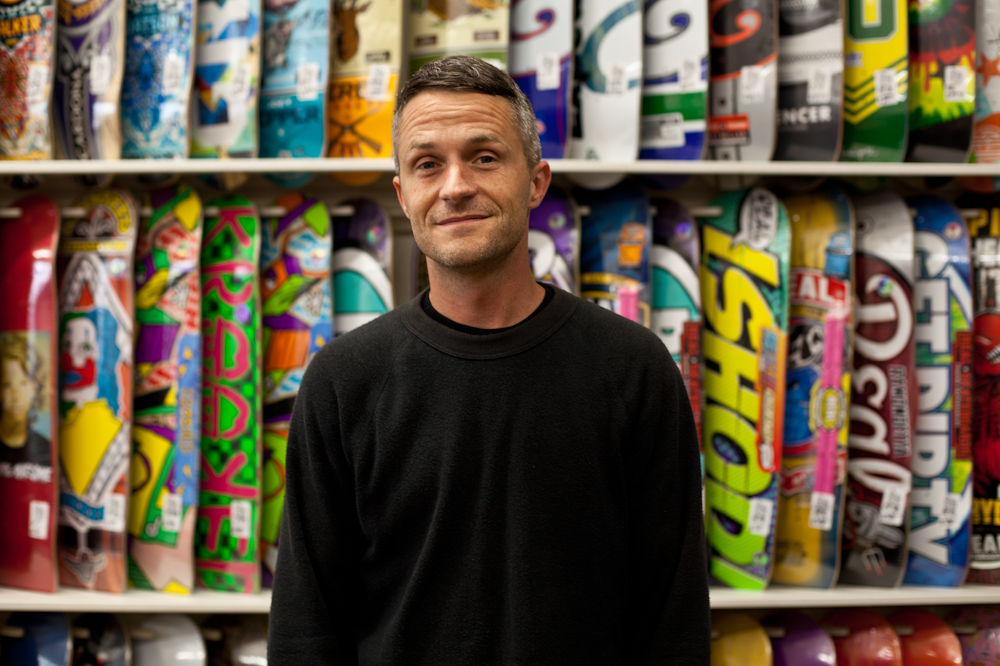
ON TO THE NEXT ONE
I have this whole new perspective on how retail is evolving in the Internet age and I just think when we first opened Bows and Arrows, my goal was to have really great product. That was the name of the game, but now that sort of turned into everyone at least either has this product or consumers are going to always have access to it on the Internet; it’s not as special to have product anymore. So I really think your space needs to be more of “the thing.” I feel like I need to focus more on the experience. So that’s been kind of a fun new exploration as to how – I can be a small indie retailer and have the kind of retail set up that is memorable or unique in some way.
There’s a million different ways you can go about that, I don’t think my approach is going to be as epic as something like The Hundreds has done in San Francisco where it’s like, “Whoa!“ My goal is for it to be memorable and distinct but on a small set up. There’s a weird dynamic going on there that I’m trying to figure out with some architects and I’m really excited about that. I think we’re going to try and do it later this year. I’ve also been working on making some changes to visual layout stuff to our website. That’s just become more my role in the store over the years. More fine-tuning. Doing cool stuff, whether it’s little projects or redoing the spaces or whatever it is. That stuff I look forward to.
We may open another store in the next couple years but I don’t know, it might be something totally different. I don’t really think I’ll necessarily open another Bows and Arrows or 510. What makes them what they are is where they are. I feel like when stores start rolling out and opening too many locations it just loses something. I spend a lot of time running these days, which is kind of a new thing for me. I’ve gotten into the running world, like, performance running stuff. I kind of see that whole side of that whole industry and that whole side of retail… I kind of wonder if I could bring my perspective into something in that world. I don’t really know if it’s something I’m going to actually pursue but it would be kind of rad.
::
::
510 Skateboarding
2506 Telegraph Ave.
Berkeley, CA 94704
Tel: 510.843.1863
Bows & Arrows
2513 Telegraph Ave.
Berkeley, CA 94704
Tel: 510.649.6683

